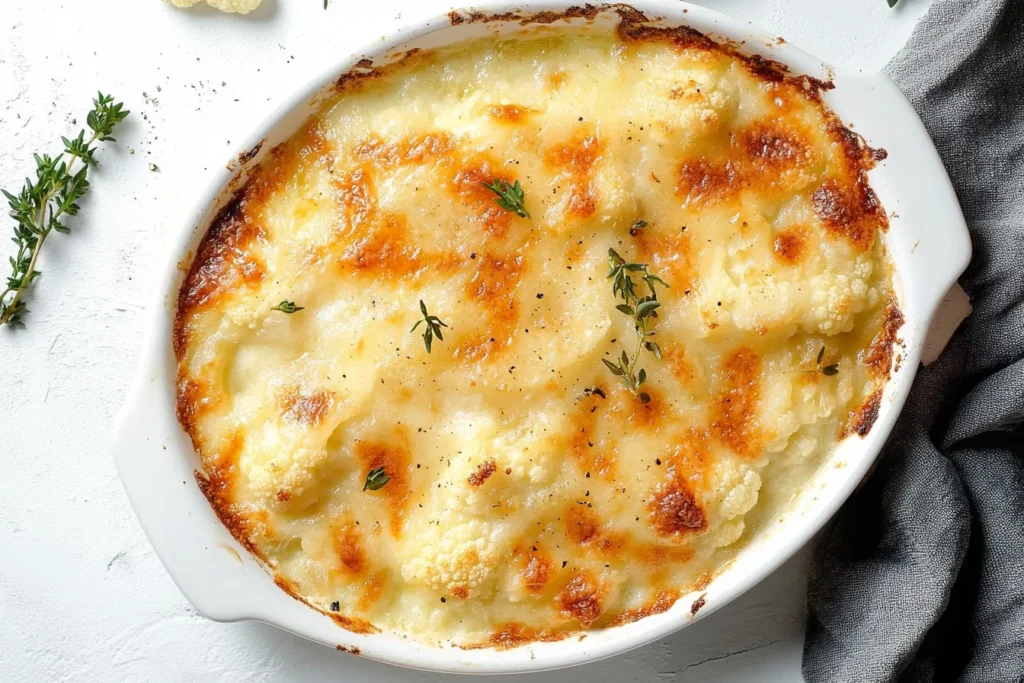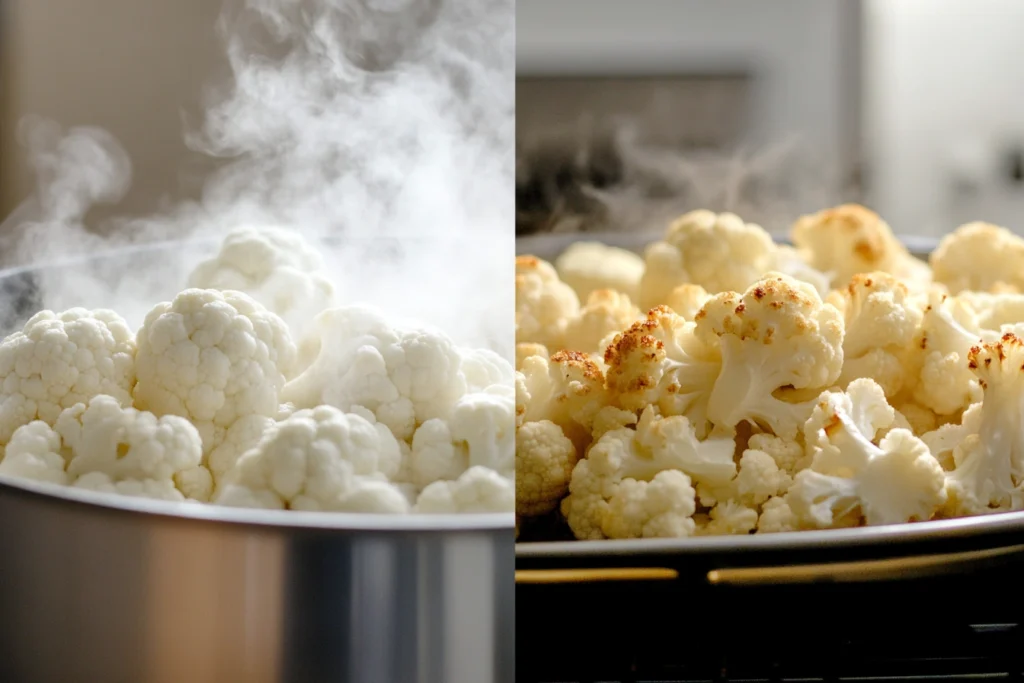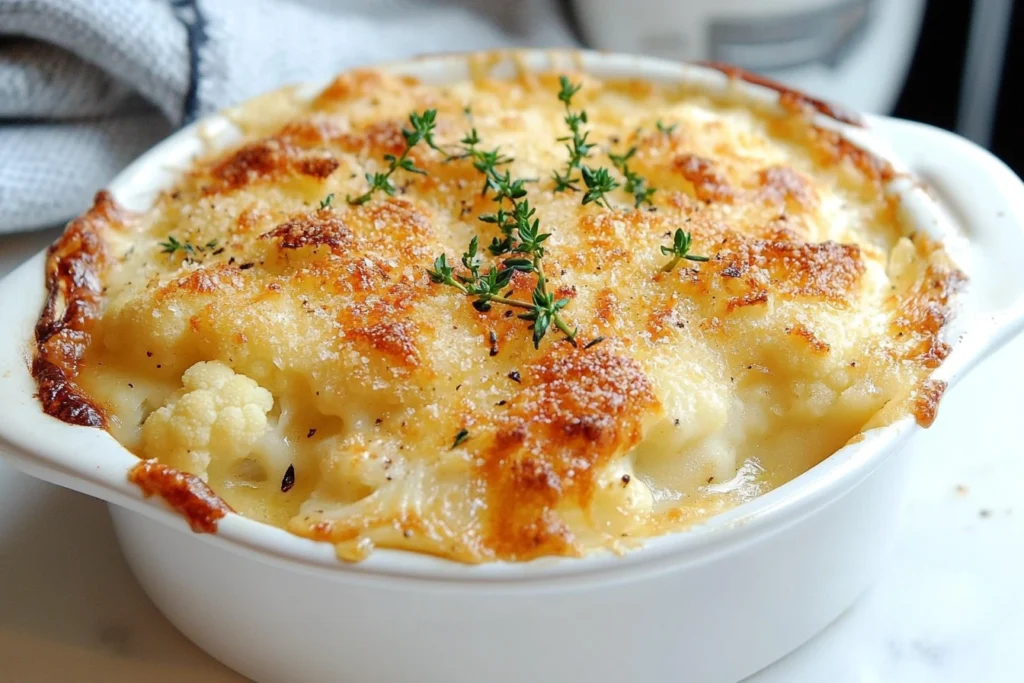Watery cauliflower gratin can ruin an otherwise perfect dish—what should be rich, creamy, and comforting turns bland and soggy. If your gratin keeps swimming instead of setting, it’s not your taste buds—it’s your technique. Here’s how to fix the moisture problem and bring back that irresistible golden crisp with every bite.

Table of Contents
Why does it become watery?
Even the most experienced cooks can face the issue of watery Cauliflower Gratin. This problem arises from either improper preparation or imbalanced ingredients. The cauliflower itself retains a lot of moisture, which, if not managed, releases during baking. Moreover, an under-thickened sauce and incorrect baking technique can compound the issue. A smooth, stable texture requires eliminating as much moisture as possible before assembly. Also, skipping essential steps like drying or draining can lead to a soupy consistency. Addressing these issues early ensures that watery Cauliflower Gratin turns out with the desired rich and cohesive texture.
Learn more about how technique matters in creamy casseroles by visiting our Green Bean Casserole thickening guide.
Common Causes of Watery Cauliflower Gratin
Excess moisture in cauliflower
Cauliflower naturally contains a high water content, which contributes significantly to watery Cauliflower Gratin. If not managed, this internal moisture leaks into the dish during baking. After cutting the florets, it’s crucial to allow them to air dry or pat them with a clean towel. Moisture left on the surface will steam rather than roast during cooking. This not only affects texture but also waters down the flavor. Ensuring that cauliflower is as dry as possible from the start can significantly reduce the chance of a watery outcome.
Over-steaming or boiling
When preparing watery Cauliflower Gratin, steaming or boiling cauliflower too long introduces unnecessary water. Although boiling softens the florets quickly, it can oversaturate them, leading to water release during baking. A better approach is to lightly steam or roast the cauliflower until just tender. Overcooking makes the cauliflower soggy, which further compromises the sauce’s integrity. By controlling how the vegetable is pre-cooked, the final texture of the gratin can be greatly improved.
For more roasting inspiration, check out our Delicious Spinach Quiche Recipe, which also benefits from properly roasted vegetables.
Skipping the drain step
Neglecting to drain cauliflower after cooking is a key reason for watery Cauliflower Gratin. Even lightly steamed florets can hold water internally. Allowing the cooked cauliflower to rest in a colander or on a paper towel-lined tray enables excess moisture to escape. Skipping this stage results in trapped water being released during baking, thinning the sauce. Incorporating this extra step may seem small, but it drastically reduces the risk of ending up with a runny gratin.
Inadequate sauce thickness
The consistency of the cheese sauce is critical when preventing watery Cauliflower Gratin. A thin sauce cannot bind the ingredients and will separate under heat, leading to liquid accumulation. The sauce should be thick enough to coat a spoon without dripping. If the sauce begins too runny, it will only worsen in the oven. Adding an extra spoonful of flour or simmering longer can help achieve the right viscosity before pouring it over the cauliflower.
Improper baking time or temperature
Baking watery Cauliflower Gratin at the wrong temperature or for too short a time allows moisture to linger. A properly set gratin requires moderate-high heat to reduce liquid and create structure. Baking at 375°F to 400°F is ideal for both bubbling the sauce and browning the top. Removing it from the oven too early means the ingredients haven’t had time to meld and stabilize. Proper baking time ensures excess water evaporates, leaving a firm and creamy result.
If you’re curious about texture contrast, explore our Ultimate Cornbread Guide—a dish where crispy tops make all the difference.
Prepping Cauliflower Properly
Choose fresh, firm cauliflower
The first step to avoiding watery Cauliflower Gratin is selecting high-quality produce. Fresh cauliflower should be firm, white, and compact. Older heads with brown spots or limp texture are likely to contain more internal moisture. These imperfections not only affect taste but increase the chance of water release during baking. Fresh, dense cauliflower also roasts more evenly and retains its shape, giving the dish a better structure overall.
Roasting vs. boiling – what’s better?

Roasting is far more effective than boiling when preparing cauliflower for watery Cauliflower Gratin. Roasting reduces moisture while enhancing flavor through caramelization. Boiling, on the other hand, saturates the florets and weakens their structure. Roasting at a high temperature (around 425°F) for 20 minutes removes water and intensifies the cauliflower’s natural sweetness. It also prevents the dish from becoming mushy once baked.
How to dry cauliflower thoroughly
Drying is a crucial, often overlooked step in preparing watery Cauliflower Gratin. After cooking, the florets should be laid out in a single layer on a clean towel or paper towels. Allow them to sit for at least 10–15 minutes. Patting the tops dry helps further eliminate moisture. For even better results, place the cauliflower in the fridge uncovered for a short period to allow any residual steam to dissipate.
Mastering the Sauce
The importance of roux
A stable cheese sauce begins with a roux—an equal blend of flour and fat. Without it, watery Cauliflower Gratin lacks the structure needed to stay cohesive. The roux thickens the sauce and helps it cling to the cauliflower. It should be cooked until golden before slowly adding milk. Whisk constantly to avoid lumps and ensure the flour is fully incorporated. This technique forms the backbone of a sauce that holds up during baking.
Best cheese combinations
Choosing the right cheese blend can also prevent watery Cauliflower Gratin. Cheeses like Gruyère, cheddar, and Parmesan melt well and offer depth. Avoid overly soft cheeses unless balanced with a firmer counterpart. The right mix contributes to both flavor and texture. Using only processed cheese or soft spreads can result in a greasy, runny sauce.
- Use sharp cheddar for richness
- Blend with Gruyère for depth
- Sprinkle Parmesan on top for texture
How to thicken a cheese sauce properly
A cheese sauce used in watery Cauliflower Gratin should not pour like soup. It needs to cling to the spoon and the vegetable. If the sauce is too loose after adding cheese, return it to low heat and simmer. Add a small slurry of cornstarch or increase the roux ratio. Avoid adding more cheese to thicken—this can split the sauce. Consistent stirring and low heat help maintain a stable emulsion.
Building the Perfect Gratin

Layering tips
Proper layering prevents watery Cauliflower Gratin from turning soggy. Begin with a thin layer of sauce at the base of the dish. Add a single layer of cauliflower, then more sauce. Repeat only once or twice to avoid overcrowding. Over-stuffing the dish reduces airflow and traps steam, which leads to a soggy texture. Even layers allow even cooking and balanced sauce distribution.
Add-ins that work (and ones that don’t)
Add-ins can enrich watery Cauliflower Gratin but should be chosen carefully. Avoid moisture-heavy ingredients like tomatoes or raw mushrooms.
Good options include:
- Cooked bacon or pancetta
- Sautéed onions
- Blanched spinach, squeezed dry
- Chopped nuts for crunch
Keep add-ins dry and pre-cooked whenever possible.
Crunchy topping ideas
A crisp topping can offset any residual softness in watery Cauliflower Gratin. Panko breadcrumbs mixed with melted butter and herbs provide a golden crunch. Crushed crackers or almond flour can also work for texture and flavor contrast. Always bake uncovered to allow the topping to crisp properly.
Baking Tips for the Best Texture
Temperature and timing sweet spots
For best results, watery Cauliflower Gratin should be baked at 375°F to 400°F for 30 to 40 minutes. This range allows the sauce to thicken and the topping to brown. If the dish isn’t bubbling by the 25-minute mark, increase the heat slightly. Avoid baking at too low a temperature, which traps steam inside the dish.
Letting it rest before serving
After baking, watery Cauliflower Gratin should rest for at least 10 minutes. This allows the cheese sauce to set and the moisture to redistribute. Cutting into it immediately will cause separation. Letting it cool slightly ensures a firmer, more sliceable gratin.
Reheating without ruining it
Reheat watery Cauliflower Gratin in a low oven at 325°F, uncovered. This helps maintain texture while evaporating any extra moisture. Avoid using the microwave, which reheats unevenly and softens the crisp topping.
Troubleshooting Watery Gratin
Quick fixes post-bake
If your watery Cauliflower Gratin is already baked and still runny, tilt the pan gently and spoon out excess liquid. Then return it to the oven uncovered for 10–15 minutes. This helps evaporate lingering moisture and sets the sauce more firmly.
Preventative steps to always follow
To avoid watery Cauliflower Gratin in the first place:
- Use fresh, roasted cauliflower
- Dry ingredients thoroughly
- Prepare a thick roux-based sauce
- Layer and bake uncovered
- Allow time to rest post-bake
These steps drastically improve consistency and prevent sogginess.
Healthier Alternatives
Using plant-based milk or cheese
Creating a dairy-free version of watery Cauliflower Gratin is possible with proper planning. Use thicker plant-based milks like oat or cashew. Vegan cheeses with starch content melt better and provide structure. Thicken the sauce using nutritional yeast and flour rather than relying on cheese alone.
Low-carb toppings
For a keto-friendly twist on watery Cauliflower Gratin, skip breadcrumbs. Instead, top with:
- Ground pork rinds
- Almond flour with Parmesan
- Chopped toasted nuts
These options offer crunch without added carbs.
Final Thoughts
Great cauliflower gratin isn’t about luck—it’s about technique. Master the moisture, layer in flavor, and bake it right. Now that you know what causes the sogginess, it’s time to make a version that holds together and tastes incredible.
Try it tonight and give your gratin the upgrade it deserves.
FAQ
Can I use frozen cauliflower?
Yes, but thaw and drain it really well. Pat it dry or roast it briefly to get rid of extra moisture.
How do I store leftovers?
Keep them in an airtight container in the fridge for up to 3 days. Reheat in the oven for best results.
What other veggies work well in gratin?
Broccoli, Brussels sprouts, or even sliced zucchini—just make sure to cook and dry them before assembling.


2 thoughts on “Watery Cauliflower Gratin – How to Fix, Prevent & Perfect Your Recipe”